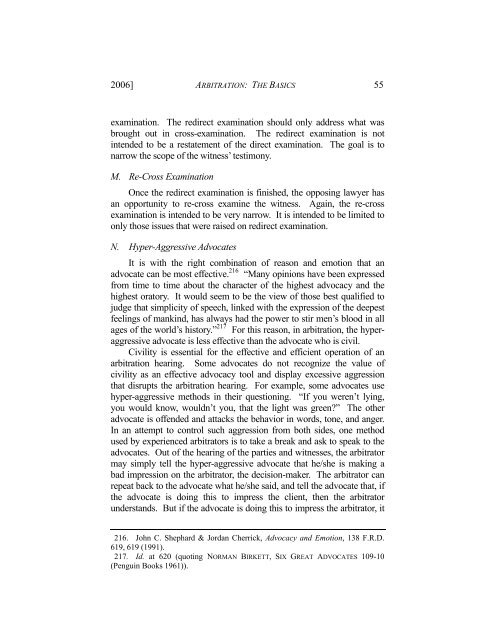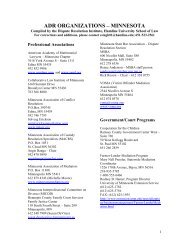2006/Vol. 5 No.1 - Hamline Law - Hamline University
2006/Vol. 5 No.1 - Hamline Law - Hamline University
2006/Vol. 5 No.1 - Hamline Law - Hamline University
Create successful ePaper yourself
Turn your PDF publications into a flip-book with our unique Google optimized e-Paper software.
<strong>2006</strong>] ARBITRATION: THE BASICS 55<br />
examination. The redirect examination should only address what was<br />
brought out in cross-examination. The redirect examination is not<br />
intended to be a restatement of the direct examination. The goal is to<br />
narrow the scope of the witness’ testimony.<br />
M. Re-Cross Examination<br />
Once the redirect examination is finished, the opposing lawyer has<br />
an opportunity to re-cross examine the witness. Again, the re-cross<br />
examination is intended to be very narrow. It is intended to be limited to<br />
only those issues that were raised on redirect examination.<br />
N. Hyper-Aggressive Advocates<br />
It is with the right combination of reason and emotion that an<br />
advocate can be most effective. 216 “Many opinions have been expressed<br />
from time to time about the character of the highest advocacy and the<br />
highest oratory. It would seem to be the view of those best qualified to<br />
judge that simplicity of speech, linked with the expression of the deepest<br />
feelings of mankind, has always had the power to stir men’s blood in all<br />
ages of the world’s history.” 217 For this reason, in arbitration, the hyperaggressive<br />
advocate is less effective than the advocate who is civil.<br />
Civility is essential for the effective and efficient operation of an<br />
arbitration hearing. Some advocates do not recognize the value of<br />
civility as an effective advocacy tool and display excessive aggression<br />
that disrupts the arbitration hearing. For example, some advocates use<br />
hyper-aggressive methods in their questioning. “If you weren’t lying,<br />
you would know, wouldn’t you, that the light was green?” The other<br />
advocate is offended and attacks the behavior in words, tone, and anger.<br />
In an attempt to control such aggression from both sides, one method<br />
used by experienced arbitrators is to take a break and ask to speak to the<br />
advocates. Out of the hearing of the parties and witnesses, the arbitrator<br />
may simply tell the hyper-aggressive advocate that he/she is making a<br />
bad impression on the arbitrator, the decision-maker. The arbitrator can<br />
repeat back to the advocate what he/she said, and tell the advocate that, if<br />
the advocate is doing this to impress the client, then the arbitrator<br />
understands. But if the advocate is doing this to impress the arbitrator, it<br />
216. John C. Shephard & Jordan Cherrick, Advocacy and Emotion, 138 F.R.D.<br />
619, 619 (1991).<br />
217. Id. at 620 (quoting NORMAN BIRKETT, SIX GREAT ADVOCATES 109-10<br />
(Penguin Books 1961)).
















